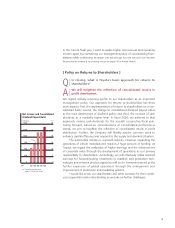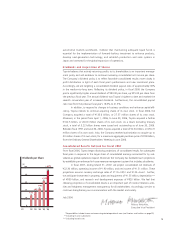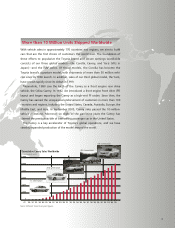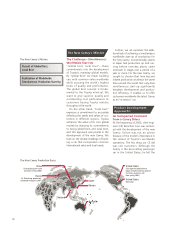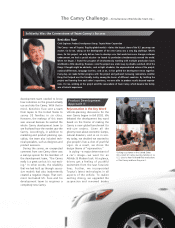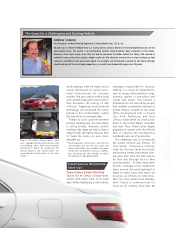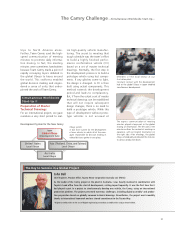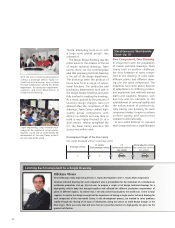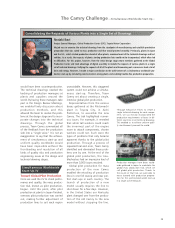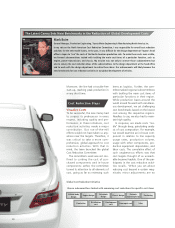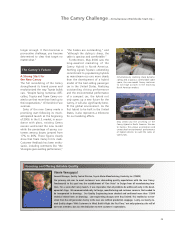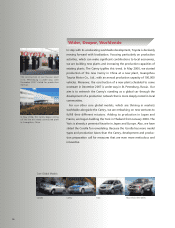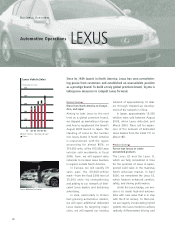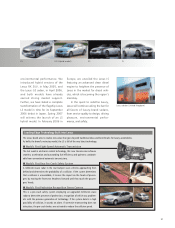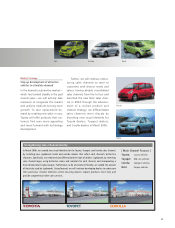Toyota 2006 Annual Report Download - page 25
Download and view the complete annual report
Please find page 25 of the 2006 Toyota annual report below. You can navigate through the pages in the report by either clicking on the pages listed below, or by using the keyword search tool below to find specific information within the annual report.
23
would have been counterproductive.
The technical drawings needed the
backing of production managers at
plants and suppliers around the
world. By having these managers take
part in the Design Review Meetings,
we enabled lively discussion about
production methods, and this
allowed the team to resolve the prob-
lems at the design stage and to incor-
porate changes into the technical
drawings. Through this global
process, Team Camry summarized all
of the feedback from the production
side into a “single voice.” It is not an
exaggeration to say that the achieve-
ment of simultaneous start-up and
uniform quality worldwide would
have been impossible without the
frontloading and resolution of all
kinds of quality risks and production
engineering issues at the design and
technical drawing stages.
Toward Global Pilot Production
Once we used the CV to check perfor-
mance and quality, the mass produc-
tion trial, known as pilot production,
began. Until this point, after pilot
production at plants in Japan finished,
overseas pilot production was carried
out, making further adjustment of
production lines to suit each region
Simultaneous Worldwide
Start-Up IV
unavoidable. However, this staggered
system could not achieve a simulta-
neous start-up. Therefore, Team
Camry set about creating a single,
intensive global pilot production.
Representatives from the various
bases gathered at the Motomachi
plant in Toyota City, in Aichi
Prefecture, to assemble the new
Camry. The trial highlighted numer-
ous issues. For example, it revealed
that while tall workers could reach
the innermost part of the engine
room to attach components, shorter
workers could not. Such were the
types of problems that only became
apparent thanks to the global pilot
production. Through a process of
repeated trial and error, Team Camry
identified and eliminated these prob-
lems one by one. At the end of the
global pilot production, the trou-
bleshooters had an impressive haul of
more than 3,000 issues resolved.
Global pilot production for mass
production of the new Camry
enabled the retooling of production
lines in one fell swoop and near per-
fect start-ups in each country. The
launch of production of a new
model usually requires the line to
shut down for a few days. However,
in the United States our Kentucky
plant changed over from the produc-
tion of the old Camry to the new
model without stopping the line.
Consolidating the Requests of Various Plants into a Single Set of Drawings
Noriaki Ikari
Project General Manager, Global Production Center (GPC), Toyota Motor Corporation
My job was to examine the technical drawings from the standpoint of manufacturing and establish production
preparation that was suited to mass production and that would proceed smoothly. Previously, plants in Japan
and the U.S., which started production ahead of other plants, examined most of the technical drawings and test
vehicles. As a result, the requests of plants starting production later could not be incorporated, which often led
to difficulties. For this project, however, from the initial design stages team members gathered at the Global
Production Center and took advantage of digital assembly to include the requests of various plants in a single
set of technical drawings. Unifying the requests of all of the plants and hammering out a consensus took a lot of
time and energy. However, it made a major contribution to the achievement of a simultaneous worldwide pro-
duction start-up by stimulating communication among plants and enabling trouble-free production preparation.
Through exhaustive efforts to create a
single technical drawing for each compo-
nent, we successfully incorporated the
production requirements of bases in dif-
ferent countries in all technical drawings.
This enabled us to achieve uniform quali-
ty simultaneously around the world.
Production managers from bases world-
wide gathered in Japan to undertake the
global mass production trial, which we
call global pilot production. Thanks to
the results of that trial, we were able to
move forward with production prepara-
tion for the synchronized world start-up
in a single concerted push.
The Camry Challenge —Simultaneous Worldwide Start-Up—


